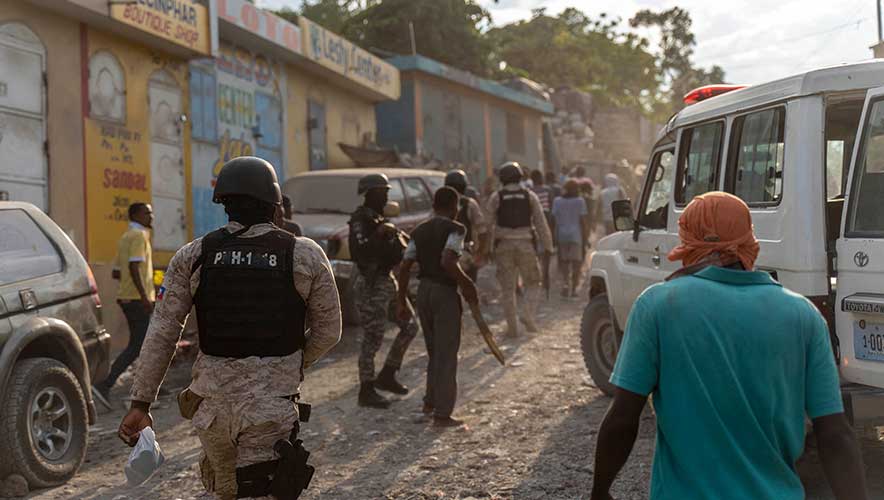Gang Violence in Haiti Fueled by Widespread Firearms Trafficking, Report Says
Firearms trafficking is taking the situation in Haiti from bad to worse. The United Nations Office on Drugs and Crime (UNODC) found that the country’s porous borders, understaffed law enforcement, and heavily armed criminal gangs are leading to an increasingly unstable environment, exacerbated by the flow of sophisticated, high-caliber firearms and ammunition.
“Virtually every metric of insecurity—from homicide, sexual violence, and kidnapping to the killing of police and migration out of the country—is trending upward,” according to the report, Haiti’s Criminal Markets: Mapping Trends in Firearms and Drug Trafficking. In 2019, there were 1,141 homicides in Haiti. In 2022, that had nearly doubled to 2,183. Kidnapping incidents sharply rose from just 78 in 2019 to 1,359 in 2022, the report said.
A recent estimate found that nearly 100,000 Haitians have been physically displaced within Port-au-Prince, Haiti, alone. “Chronic instability is contributing to rising food prices, surging hunger, dangerous cholera outbreaks, deepening poverty, and the potential for a major migration exodus,” the report said. In 2019, 932 Haitian migrants were detained by the United States, compared to 7,175 people in 2022. And 43,900 Haitians (including as many as 1,800 children) were reportedly deported along the Dominican Republic border between July and October 2022.
The heightened violence in Haiti following the 2021 assassination of President Jovenel Moïse has many international agencies worried about a potential national collapse. Gang violence in particular is sparking concern: “Many of the country’s estimated 150-200 gangs are deeply enmeshed in complex patronage networks aligned with a constellation of political and economic elites,” the report said. These connections let gangs wield significant influence in and around the capital, and they are targeting critical infrastructure such as ports, fuel terminals, and key roads in and out of major cities. In December 2022, the UN estimated that gangs controlled up to 60 percent of the Haitian capital of Port-au-Prince, but residents say it’s closer to 100 percent, the Associated Press reported.
The UNODC said that a network of criminal actors are sourcing firearms from the United States and smuggling them into Haiti by land from the Dominican Republic, by air to clandestine airstrips, and by sea. While some international agencies and humanitarian groups are offering to bolster the Haitian government’s ability to deter and suppress armed gangs and secure the country’s borders, these efforts are “not at a scale that can meaningfully deter and reduce the flow of weapons, drugs, and other contraband,” according to the UNODC report.
New @UNODC report shows alarming levels of gang violence & criminal activities in Haiti.
— GhadaFathiWaly (@GhadaFathiWaly) March 4, 2023
Between 2021-2022:
-3,798 homicides
-2,023 kidnappings
-5t cannabis & 67kg cocaine seized
-743 firearms seized
Urgent action is needed to break the cycle of crime, corruption & lawlessness. https://t.co/mzdYFrOscL
Haiti is broadly dependent on imports (approximately half of all cooking products used by Haitians are imported), so the nation has a vast cross-border exchange of goods but lacks sufficient policing and customs authorities to manage that flow. The border is long—1,771 kilometers (1,100 miles) of coastline and 392 kilometers (243 miles) along the border with the Dominican Republic—and staffing shortages and other challenges have forced some customs and security stations to close. In addition to their inability to monitor for incoming contraband, border and customs officials are frequently targeted by gangs. “The threat of kidnapping and ransom is ever present,” the report noted.
Firearms have been flowing into Haiti in shipping containers, in air freight consignments, hidden in trucks or cars, or carried by individuals—often middlemen in Caribbean ports or the Dominican Republic. While Haitians can legally import firearms, ammunition, and parts for public and private security agencies, the estimated number of guns in Haiti far outweighs that market. The Haitian National Police registered 38,000 “legal” firearms in 2015, the report noted, but a 2020 estimate tallied as many as 500,000 small arms in the country.
“Assuming these figures are remotely accurate, Haiti’s law enforcement agents are outgunned by Haitian residents, private security personnel, and armed gangs,” the UNODC report said.
A popular source of firearms in Haiti is the United States—especially Florida—and traffickers can make a solid profit on the trade. A popular handgun in the United States can cost $400-$500 at a federally licensed firearm outlet, but it can be resold in Haiti for as much as $10,000. High-powered rifles such as AK-47s, AR-15s, and Galils are in higher demand from gangs and fetch higher prices, the report said.
Weapons and ammunition have been found in shipments of beans, rice, and other food products, as well as in containers addressed to the Episcopal Church, labeled as relief supplies. Port security officials often lack the resources and staff to thoroughly search every shipment, though, so the UNODC report noted that the current "iron pipeline" of weapons into the country is proving particularly difficult to stop.










